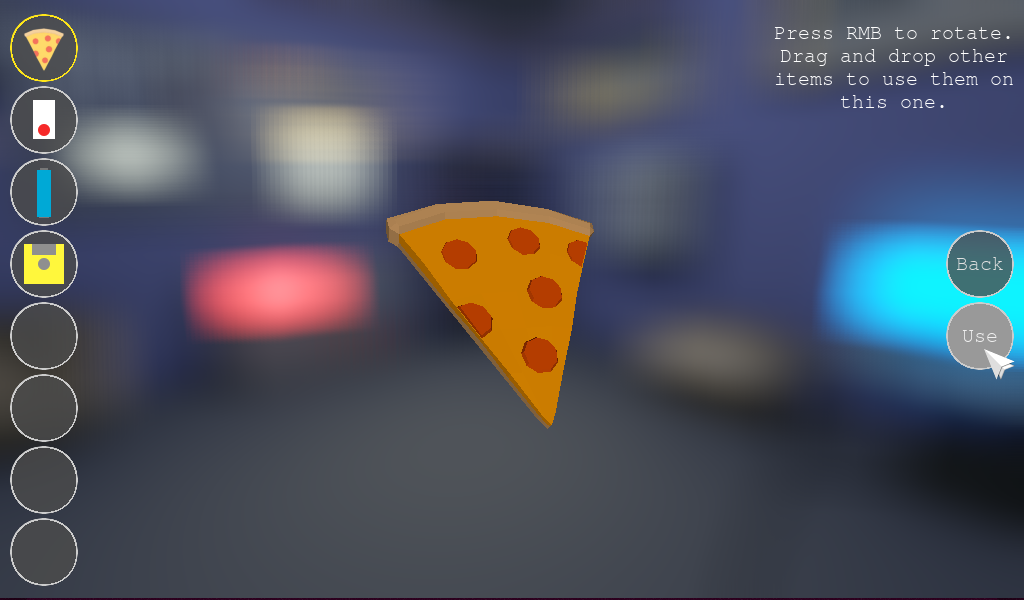Inventory¶
GOAT offers an inventory system. It holds a maximum of 8 items, each
represented by a 3D model that can be rotated and interacted with. Items
can be added either by your script or automatically when an
INVENTORY interactive item is activated. You can also use items on
each other (drag and drop), on themselves (“Use” button), or on
environment (using the custom inventory, explained in the next section).
You can open the inventory by pressing Tab while in EXPLORING mode.
In inventory, you can rotate items by holding RMB and moving the mouse.
You can also interact with items by clicking on them with LMB (that is,
if they contain any interactive parts). Clicking on a button on the left
side selects a different item.

To use the inventory, you need to register an inventory item first:
goat_inventory.register_item(item_name)
Inventory items must be stored in the inventory_items directory of
your game resources folder. You need to provide both a 2D icon (shown in
the inventory bar), and a 3D model. item_name must match both files
(without extension, and following Godot’s naming convention for scenes).
For example, a floppy_disk item would need the following files:
demo/inventory_items/
├── icons
│ └── floppy_disk.png
└── models
├── FloppyDisk.gd # This is not obligatory
└── FloppyDisk.tscn
And the registration would look like this:
goat_inventory.register_item("floppy_disk")
Icons have to be 64x64 PNG images, and should have a transparent background. Models can be any Spatial scenes, and can have additional logic included in a script. Models should be centered in (0, 0, 0) and should not be larger than a sphere with a 1 unit radius (otherwise they will not be displayed properly).
Item registration process stores the names of icons and models, but nothing more. At some point you might want to actually load those resources:
goat_inventory.get_item_icon(item_name)
goat_inventory.get_item_model(item_name)
Icons are returned as a StreamTexture, models as a PackedScene
(which has to be instanced). Both of these methods are used internally
by GOAT and usually don’t have to be accessed directly by game
developers.
You can add, remove, and replace items in the inventory using the following methods:
goat_inventory.add_item(item_name)
goat_inventory.remove_item(item_name)
goat_inventory.replace_item(replaced_item_name, replacing_item_name)
You can also use items, but that part is handled automatically by GOAT and there is usually no reason to use it directly:
goat_inventory.use_item(item_name, used_on_name=null)
item_name is an inventory item that you want to use on something
else. used_on_name can represent another inventory item, an
interactive item or screen (property unique_name) or it can be null,
meaning that you use the item on itself or on the player (e.g. use a
pizza slice = eat it, use a lamp = turn it on).
GOAT also allows you to select one of the inventory items. That item will be shown in the 3D inventory. If the inventory is empty, then no item is selected.
This feature is usually managed by GOAT, but sometimes you might want to select a specific item to bring more attention to it. You can do it like this:
goat_inventory.select_item(item_name)
item_name can be null, which means that you deselect the current
item.
Each action mentioned above emits a signal:
goat_inventory.item_added (item_name)
goat_inventory.item_removed (item_name)
goat_inventory.item_replaced (replaced_item_name, replacing_item_name)
goat_inventory.item_used (item_name, used_on_name)
goat_inventory.item_selected (item_name)
Moreover, every time the content of the inventory changes, this signal will be emitted:
goat_inventory.items_changed (new_items)
new_items is the current content of the inventory (as Array), in
order the items were added to it.
You can also access the list of items or the selected item at any time:
goat_inventory.get_items()
goat_inventory.get_selected_item()
If you want to clean the content of the inventory (but keep the
inventory item configuration created by register_item method) you
can do it like this:
goat_inventory.reset()